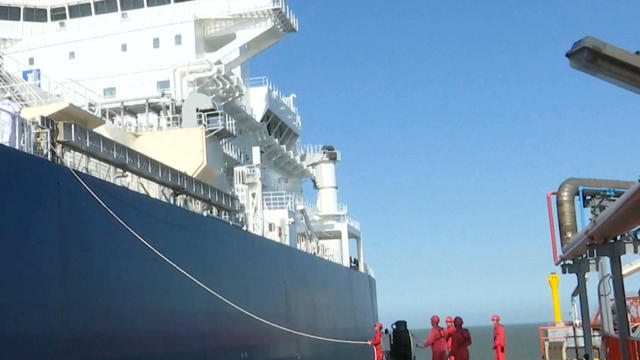With its crackdown on pollution, China is on track to become the world’s biggest importer of natural gas, a much cleaner energy alternative to coal. Fueling that rise in imports coming from above the Arctic Circle is a massive liquefied natural gas production facility in Russia.
CGTN’s Su Xiaoxiao reports.
The Yamal plant is the world’s largest liquefied natural gas project operated above the Arctic Circle.
Exploitable natural gas reserves there are estimated at 1.3 trillion cubic meters.
After 23 days at sea, a Russian tanker arrived in East China’s Jiangsu Province, delivering the first direct shipment of natural gas from the North Pole.
For the first time, the shipment came via the Northern Sea Route which can be only used during summer months, after the thicker winter ice has melted.
It cuts travel time almost in half, as it’s about 13,400 kilometers (over 8,300 miles) shorter than the traditional eastern route via the Suez Canal.
Beijing hopes the latest gas deal with Moscow will contribute to China’s energy reform.
PetroChina’s Zhang Chenwu, who is in charge of the company’s international business, describes the project as a joint effort made possible by the ample resources in Russia, the steady market in China, and the high-end technologies Western countries use to produce liquefied natural gas (LNG).
China owns a nearly 30 percent stake in the $27 billion Russian operation, and Russia has big ambitions for Yamal and its service to China.
Beijing believes that in the next 10 years, the bilateral trade volume of natural gas between China and Russia will exceed 70 billion cubic meters, and that Russia will become the largest natural gas supplier to China.
The opening of the Northern Sea Route comes at a time when China faces challenges in its energy sector reforms, shifting from coal-fired power to gas, a much cleaner energy.
But that policy led to a gas shortage in the north last winter, and officials are working to avoid that situation again.
Another project underway toward that end is a 3,000 kilometer (over 1,800 miles) gas pipeline known as the “Power of Siberia” linking Russia to China. It’s due to come online by the end of 2019, and there’s already talk of a second parallel pipeline along the same route.
As for the output from Yamal, China has so far received two shipments from the Arctic. A third tanker is expected to reach the coast of northern China in the coming days.
Keun Wook Paik discusses China-Russia energy cooperation
CGTN’s Mike Walter spoke with Keun Wook Paik, a senior research fellow at the Oxford Institute for Energy Studies, about the significance of the Arctic Energy Route.
 CGTN America
CGTN America
